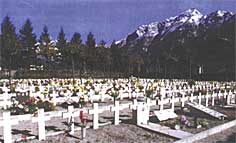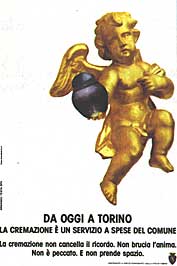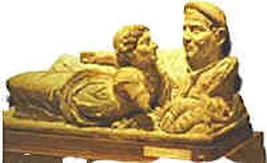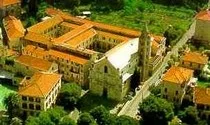Cremation
CREMATION OR NOT ?
Time of tolerance.
Since ancient times Christianity has approved of cremation as well as burial. Evidence of this can be found in Archaeological museums where monumental sarcophagus and cinerary urns of varied dimensions and elegance may be viewed. At the end of the eighteenth century Europe resumed the practise of cremating the dead. The proximity of cemeteries to water supplies together with the lack of a proper sewerage system necessitated this procedure, also the outbreak of plague and cholera contributed to this decision. Rulers and hygienists insisted to transfer the cemeteries, which often, with the development of the urban center, became to be inside of the inhabited centers.  The preparation and the realization of Risorgimento caused a serious ideological distortion in the diffusion of this practice, which finished to be presented in a certain way seriously injurious to the faith and the Christian ethics. His zealous advocates, in fact loaded it with motivations and polemic extraneous to his nature, that is the negation of spirituality and of immortality of the soul, the refusal of the dogma of the "resurrection of the bodies" professed habitually in the liturgy, an anticlerical spiteful and sour polemic, often free and groundless.
The preparation and the realization of Risorgimento caused a serious ideological distortion in the diffusion of this practice, which finished to be presented in a certain way seriously injurious to the faith and the Christian ethics. His zealous advocates, in fact loaded it with motivations and polemic extraneous to his nature, that is the negation of spirituality and of immortality of the soul, the refusal of the dogma of the "resurrection of the bodies" professed habitually in the liturgy, an anticlerical spiteful and sour polemic, often free and groundless.
Nineteen century Anticlericalism
In the last three decades of the XIX century entered the field the Freemasonry reconstituted from the ashes in 1859, and the situation worsened further because it took sides on adverse positions to the Church, that carried it sometimes out of their own constitutional rules, as his members, during the initiation swear on the Bible "faith in God and in the immortality of the soul." In those years this association did almost everything wrongly. Cardinal Pietro Palazzini in Catholic Encyclopedia (IV, 841) at the entry "Cremation" reads: " Freemasonry has many responsibility in this respect. Though is not possible, for insufficiency of proofs, impute her the genesis (all that must be excluded!) of this movement, is sure that has favored it in all the ways, for reason above all, anticlerical, looking for a character of independence and a spirit of liberty of thought, and free herself from religious traditions, is the principal cause of the condemnation by the Church." Between the Milanese lodge and the Turinese one, particularly, and respectively, between Cisalpina and Reason in Milan and the Turinese sisters Pietro Micca- Ausonia and Dante Alighieri, was established an harmonious and continuous relationship, that were a great deal undesirable for the Church. In these cities and in others one was constituted Italian Societies for the cremation that established contacts with foreign ones.
Between the Milanese lodge and the Turinese one, particularly, and respectively, between Cisalpina and Reason in Milan and the Turinese sisters Pietro Micca- Ausonia and Dante Alighieri, was established an harmonious and continuous relationship, that were a great deal undesirable for the Church. In these cities and in others one was constituted Italian Societies for the cremation that established contacts with foreign ones.
Some ceremonies took effect with public clamor, including processions and discourses, like it happened in Milan for the cremation of the Swiss dealer Albert Keller and in Turin for the merchant Isidoro Hess. It happened the same for the cremations of Luigi Pianciani, first mayor of Rome, and Luigi Castellazzo, both high dignitaries of Giustiniani Palace. Pianciani, in his last wish wrote: "I don't want at my death neither religious functions, neither sounds of bells, neither priests around my bed, these are my ideas and I want them complied with" (Isastia, 245). Hygienist Caetano Pino, in 1886, as he concluded a lecture in the intent also to discourage the attempt of Conciliation in action in the Government": O High Pontiff from Rome, while you from the Vatican Palace curse us and pursues with your anathema, we here gathered we bless you and above all the citizens of Italy proclaim you well deserving because, persisting in the medieval politics of your predecessors, you break any argument in the hands of the timid rulers to achieve an impossible conciliation between the State and the Church" (Isastia, 257).
The interventions of the Holy See
Likewise radical trumpets rang from Catholic part. The "Civilta' Cattolica", in this sense, it was an authoritative standard- bearer and very listen to, above all for the work of fathers Valentino Steccanella and Raffaele Ballerini. The first document of ecclesiastical sentence is the decree of the Inquisition "Non Pauci" that carried the subtitle "Quoad cadaverum cremationes" and dated May 19 1886 (Acta Sanctae Sedis, 1886, p. 46; "Civilta' Cattolica" 1886, 111, p. 358).
To the question if was permissible to enroll in society for cremation, the Vatican ministry answered in the negative, and specified that when such associations have connections with the Freemasonry "they incurred in the punishments, inflict to the same" that is the excommunication. Priests were interdicted to entry in crematories. The ministry took over any interventions on the subject. With the verdict "In various dioceses" of December 15 1886 (Fontes codicis juris canonici, IV, n. 1103, p. 430) ordered that ecclesiastical burial be given only to the deceased that have been cremated not for their own wish, and be denied to the others. Palazzini reviews the other interventions schematically. The decree of July 27 1892 denied the sacraments to the believers that, also without support of Freemasonry, had arranged their own cremation and prohibited public mass in their suffrage. Reaffirm that cremation is unlawful if "done with the mind to infringe the Catholic precept, also bearing the material collaboration provided that removed from the ceremony any sign of adhesion to the Freemasonry sect or of hostility to the Church" (Collectanea S. Congr. De Propaganda Fide, n. 1808). In the education of August 3 1897 to the Mother Superior of the Nuns of Maria SS. Our Lady of Sorrows is tolerate the cremation of amputate limbs, if ordered by the physician, also suggesting that is preferable inter them in blessed place (Acta Sanctae Sedis, A. 30, 1897, p. 630). In the answer of February 25 1926 to the bishop of Linz, is told that if in front of negation of ecclesiastical burial, a minister (non catholic) is called, who has done so, is suspect of heresy and he/she could not be admitted to the sacraments (Acta Apostolicae Sedis, A. 18, 1926, p. 282). In the education of June 1926, since the recourse to cremation spreads more and more, reaffirm the doctrine that the Holy See has already manifested. The cardinal comments: " society of cremation are certainly forbidden. But not under censorship, unless they are affiliations of the Freemasonry. Also the non catholic are kept to observe the law of the Church" (Catholic Encyclopedia, IV, 841)
The Code of 1917
The rejection of cremation was enacted in the Code of 1917. Can. 1203 #1 establishes: "The bodies of believers must be buried, and their cremation is forbidden." # 2: "If anybody will have ordered that his own body be cremated, it is illegitimate put this wish in execution. If this comes as addition to the contract, to the will or to any other action, it should be consider like not addition at all." Can.1240#1 n. 5 establishes that whoever will have arranged to be cremated must be excluded from ecclesiastical burial. And Can. 2339 orders that those people which infringe these dispositions contracts the excommunication latae sententiae (that is automatic) nemini reservata; those people that then spontaneously give this type of burial acquire the interdict, that is the prohibition of entry in church, reserved to the Ordinary of the place. Serious measures, that more and more clearly are considered entirely of disciplinary kind. The Catholic Encyclopedia concludes: "If only in disciplinary field the circumstances require it, the Church can, without contradiction, change dispositions. And also today is not against it, in case the cremation is demanded in extraordinary circumstances, like wars, epidemics or for a correct reason of public good."
 In effects the prohibition was not absolute, as it seemed during the rage of the polemics. The document of the acceptance cremation since 1963, and the comments that accompanied it kept reservations only when there was the aggravating circumstance of the "sectarian spirit," but they didn't minimize the existence of the exceptions, that is of the animus fundamentally tolerant of the Church. In this sense the highest point was reached before 1963 in Japan. May 23 1964 the Catholic agency N.C.W.C. informed from Matsuzaka that "the cremation, hugely in use in those regions, has been incorporated in the rite of Christian funeral, and that, at least in Japan, this concession already in use for some years" (Civilta' Cattolica, 1964, 11, p. 604).
In effects the prohibition was not absolute, as it seemed during the rage of the polemics. The document of the acceptance cremation since 1963, and the comments that accompanied it kept reservations only when there was the aggravating circumstance of the "sectarian spirit," but they didn't minimize the existence of the exceptions, that is of the animus fundamentally tolerant of the Church. In this sense the highest point was reached before 1963 in Japan. May 23 1964 the Catholic agency N.C.W.C. informed from Matsuzaka that "the cremation, hugely in use in those regions, has been incorporated in the rite of Christian funeral, and that, at least in Japan, this concession already in use for some years" (Civilta' Cattolica, 1964, 11, p. 604).
The abrogation of the sentence and the overcoming of the Catholic distrust were put in practice with the Instruction of the Holy Office dated 8 May 1963. The document was published entirely on the Osservatore Romano on September 30 of that year; the Civilta' Cattolica published it in 1964 (IV, pp. 191- 192). The preface reaffirms the usual preference for burial and presents the reasons of the change: "The Church has always observed to inculcate the burial of the body, surrounding such action with rites destined to put in prominence the symbolic and religious meaning, inflicting canonical penalty against those people that act against the general rule; and especially when the opposition bore from adverse mind to the Christian customs and to the ecclesiastical traditions fomented by sectarian spirit of whoever proposed replacing the burial with the cremation in sign of violent negation of our dogmas, especially the resurrection of the bodies and the immortality of the soul. This intention was evidently a subjective fact, risen in the mind of the promoters of the cremation and not inseparable objectivity from the same cremation; in reality the burning of the body, doesn't touch the soul neither prevents the Divine Omnipotence to reconstruct the body, as doesn't contain, in oneself and for oneself, objectify negation of those dogmas. Therefore intrinsically is not a bad thing or contrary to the Christian religion. And that was always felt by the Church, as result from the fact that, in given circumstances, and that is when resulted that the cremation of the body was asked with honest mind and for serious causes, especially of public order, she was accustomed to allow the cremation" (Civilta' Cattolica, IV, pp 191-192). The Vatican document adds that in recent times applications to the Holy See to reform the discipline in use have multiplied. The Church make changes to the canons 1203 and 1240 of the Code 1917, admitting dispensation to the burial "only when ascertain that the cremation is not wanted as negation of the Christian dogmas, or with sectarian mind, or hate against the Catholic religion or against the Church."
The present canonical discipline
The new canonical discipline comes explained in four points: 1) prefer the burial; the Ordinary exhort the believers to abstain from cremation; 2) the rule of Code 1917 is maintained when the cremation "is wanted like negation of the Christian dogmas or with sectarian mind or for hate against the Catholic religion or against the Church"; 3) to whoever arranges his own cremation in the aforesaid spirit "they won't be denied, the sacraments and the public suffrages"; 4) "to not weaken the attachment of the Christian people to the ecclesiastical tradition and to show the aversion of the Church to cremation , the rites of the ecclesiastical burial and of subsequent suffrages won't ever be celebrated in the place where occurs the cremation and not even the body will be accompanied."
The liberating text of 1963 is followed by an explanatory annotation that manifest worry emerged also in other occasions, when it has been dealt with the elimination of an excommunication. In this sense deserve a particular mention what happened in 1983 when it was promulgated the Code now in use, that didn't mention the excommunication against the Freemasonry. In this case the Vatican Ministry wanted to avoid the danger to arouse a "scandal" and has reduced the tones, maintaining the rigor only for the sectarian implications: "The Holy Office has not repealed the canonical laws, but has sweetened the application with a simple change of conceitedness of it. Up to yesterday, due the mentality with which it came publicized, the cremation must presume a choice and practiced in opposition to the doctrine of the Church[...] Today the mentality has changed, and it could be presumed that it happen for honest motives[...] If in the past cremation must be forbidden with general and absolute law, now could be tolerate, except the cases in which it is always apparent the permanency or the rebirth of the antiquated mentality, in front of which the ancient norms remain in effect[…] With this sweetening of procedure the Church takes note of some necessity of present day and a comforting regress of certain resentful and sectarian mentality against Christians, to which it was necessary to oppose resistance" (Civilta' Cattolica, IV, p. 192).
June 5 1964 the Vatican Radio reassumed the content of the document, tightening the reserves to the only motivations of religious order: "cremation, in respect to a conventional simbology, has been adopted often, above all in Europe, with intentions deliberately against Christians and against religion, like declared refusal and open negation of the faith in the resurrection of the bodies and in the immortality of the soul. To the light of this frequent attitude in the past, the Church has inflicted serious penalties[...] But, the cremation is not contrary to any truth, neither of natural order neither of supernatural order, so much less could be considered a limit, an obstacle to the Divine Omnipotence for the resurrection of the bodies. The Church, aware of this truth, is not been opposite ever, neither opposes a cremation justified from serious and important motives, above all of public order" (Civilta' Cattolica 1964, 11, p. 604).
The Code in use today has been promulgated with the apostolic constitution Sacrae disciplinae leges of John Paul II on January 25 1983. It simplifies the matter, in the chapter devoted to the ecclesiastical funeral rites. In 1176 #3 reassumes in few lines all the maturation happened in antecedence: "The Church recommends warmly that it keep the pious custom of bury the bodies of the dead persons; but doesn't prohibit the cremation, unless it has been chose for reasons contrary to the Christian doctrine."
(Freely translated by an article of Rosario E. Esposito appeared on VITA PASTORALE on October 10 2003).

